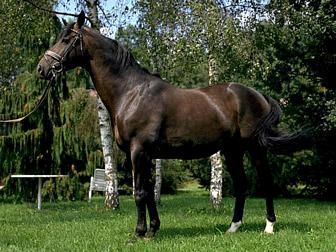
OVERVIEW
One of Europe's most famous breeds of horse is the Trakehner. This breed originated with the founding of the Trakehner stud in East Prussia by Frederick William I in 1732. Using local stock and Arabs imported from Prince Radziwill's stud in Poland, the Trakehner emerged as an attractive and durable breed suitable for work under saddle or in harness on the farm. East Prussia was once the pre-eminent horse producing region of Germany, but the defeat of Germany in 1945 led to a retreat from this area, and 1200 of the 25,000 Trakehners embarked on a three month march to the west. Many were mares in foal and a considerable number could not endure the rigorous journey. Those that did endure assured the survival of the breed.
PHYSICAL DESCRIPTION
The Trakehner is noted for a beautiful appearance enhanced by an excellent disposition. It resembles the Thoroughbred, having a fine head, arched neck and well-sprung ribs. It has muscular shoulders and quarters and clean legs. The breed appears in varying solid colors and stands between 16 and 16.2 hands. It makes an excellent jumper, dressage horse and combined training horse.
ORIGIN
The Trakehner is native to East Prussia, now a part of Poland. One of the contributing factors to its soundness is the environment in which it was raised, an area of well-drained pastures, rich in lime and phosphates. The Trakehner is still bred in Poland, and descendants of the breed which escaped to the west in 1945 are frequently called "East Prussians." The Trakehner is now considered the finest warm-blooded horse in Germany. Its conformation has been modified by a substantial presence of Thoroughbred blood in its background.
INTERESTING FACTS
One of the great legends in the history of the horse is the flight of the Trakehner from East Prussia to the west in 1945. When the Russians invaded East Prussia after the collapse of the German army, about 1200 Trakehners were herded in the direction of West Germany. Their journey took three months, and many of the horses fell by the way. Of those that survived, many were mares in foal. The incredible difficulties surmounted by these horses give ample testimony to the Trakehner's strength, spirit and durability.
INFLUENCES
1. Schweiken
2. Arabian
3. Thoroughbred
For more information:
American Trakehner Association, Inc.